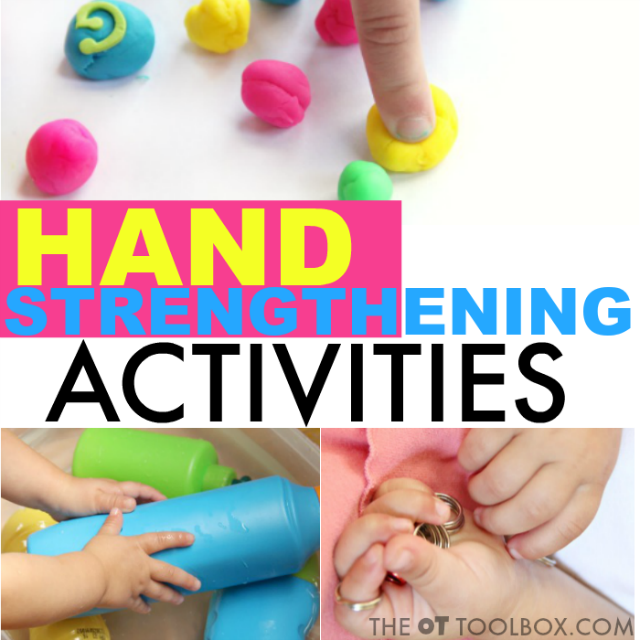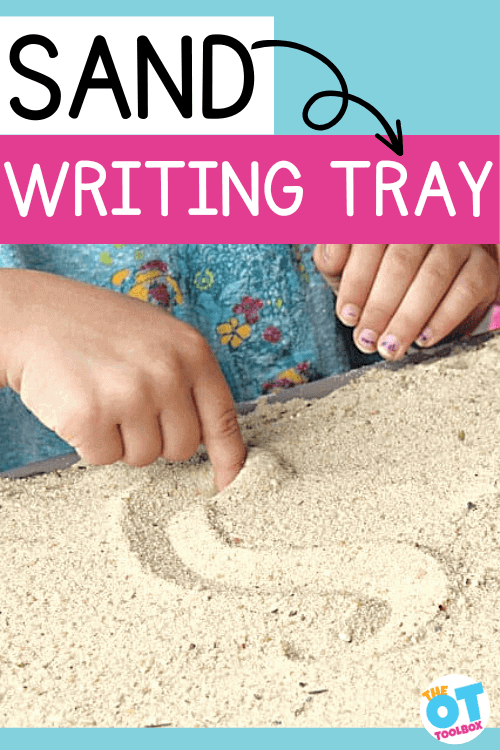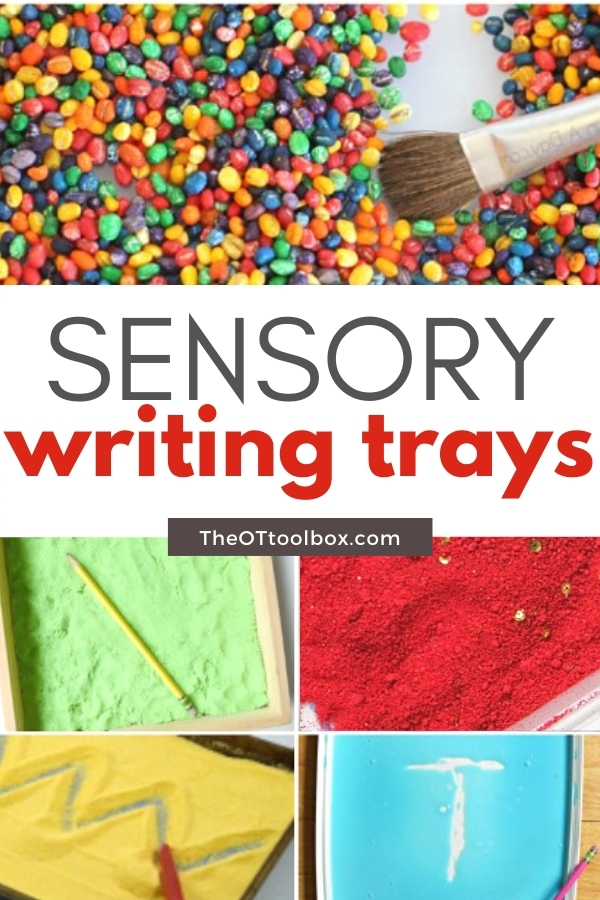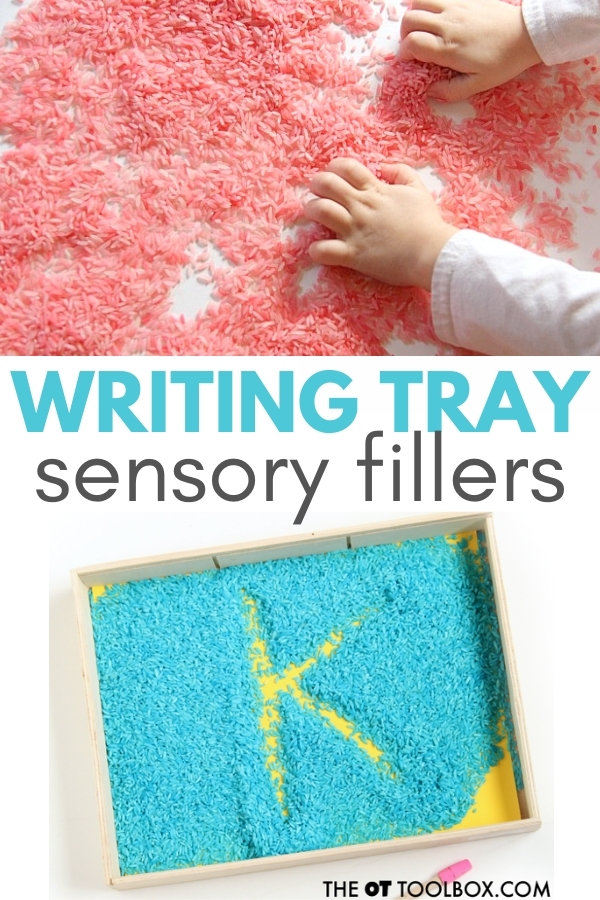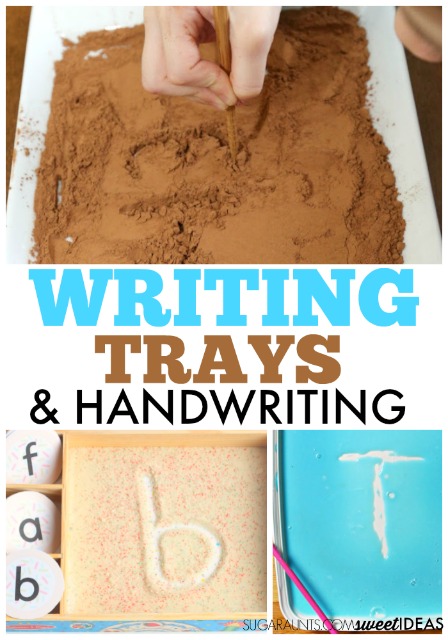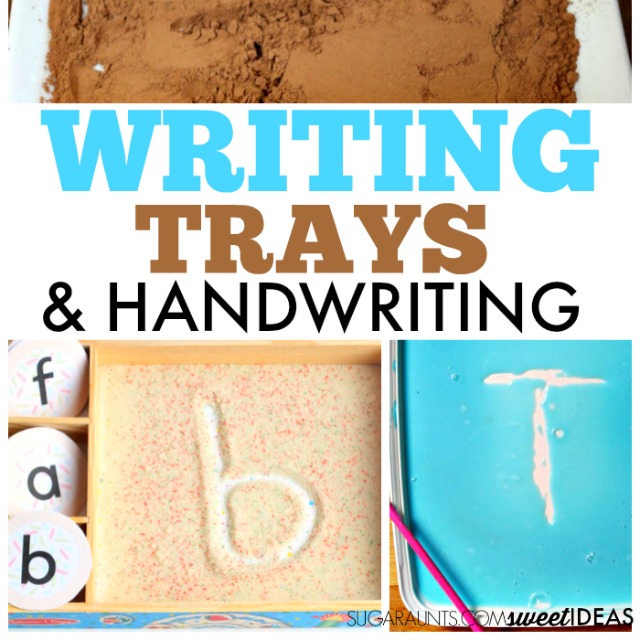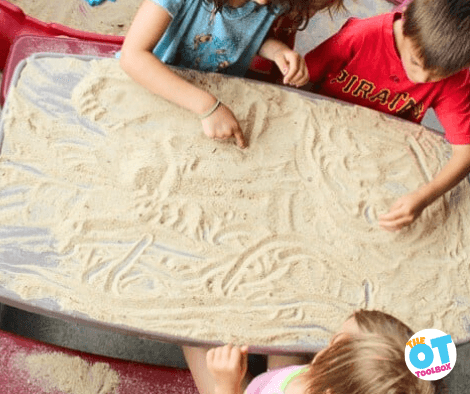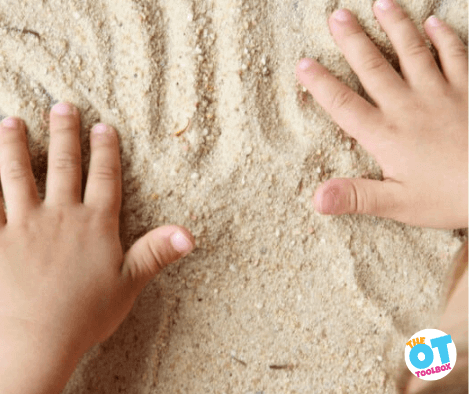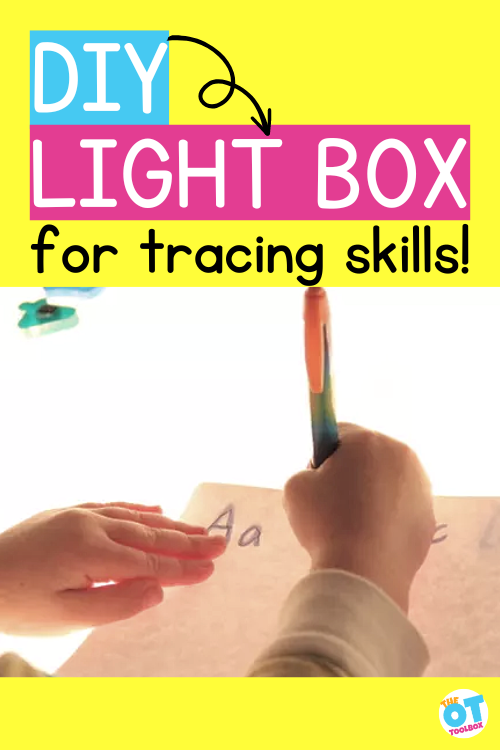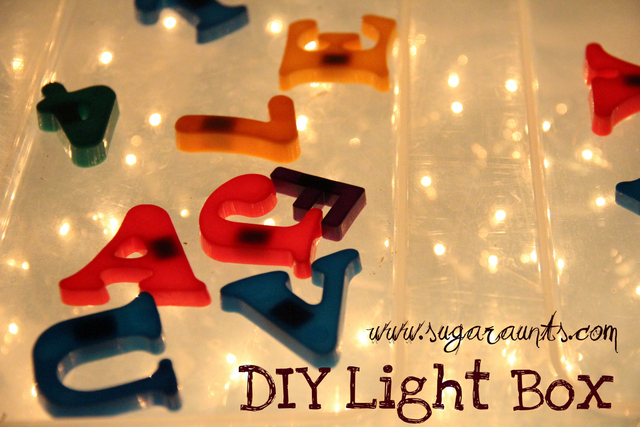Hand strengthening and finger strengthening are a part of occupational therapy interventions, in every day tasks. There is more to developing strong and efficient hands than just using a hand grip exerciser or therapy putty to strengthen fingers.
Here, you will find a collection of fine motor resources and hand strengthening activities that can be used to improve tone in the hands, increase stability in the thumb and fingers, develop and define arches of the hands, improve precision with in-hand manipulation, improve endurance in hand strengthening activities.
Below, you will find hand strengthening activities for kids, hand strength activities for adults, and therapy tools to develop hand strength. The activities to strengthen fine motor skills included in this post are perfect to improving grip strength, pinch strength, or as part of a finger exercises program for handwriting.
Hand Strengthening
Let’s take a closer look at hand strengthening…in fun and creative ways!
Occupational therapists use functional tasks, or daily occupations, to improve hand strength so that the clients they work with can lead functional lives: so they can have strong and efficient hands to do those tasks that take up their day.
Think about it this way: with weak hands, it is very difficult for a child to color a coloring page. But, through coloring and using crayons, they are improving their hand strength so they can color larger pictures or tackle more difficult fine motor tasks.
Adequate finger and hand strength is a crucial foundation skill necessary to successfully perform most activities of daily living such as opening snack wrappers, flushing the toilet, opening the tap, buttoning your shirt and so the list goes on.
Not only do we need adequate hand strength for our ADLs, it directly impacts on our ability to perform school related tasks such us cutting, writing and manipulating materials such as glue.
How do you know if a child has weak hands?
Hand strength is an important area of development.
Kids who struggle with hand strength may have difficulty with grasping a pencil, coloring, holding and using scissors, managing clothing fasteners, attaching a seatbelt, squeezing a glue bottle, opening and managing food containers, tying shoes. There are many fine motor activities needed in school that will be a red flag for determining if a child has weak hands.
Luckily, there are many fun ways to improve a child’s hand strength.
the best way to improve overall strength is through meaningful and motivating activities…especially everyday play!
Here, you will find a collection of pinching, pulling, and pushing activities, weight bearing activities, squeezing activities, and overall grip and pinch activities.
These ideas improve tone in the hands, increase stability in the thumb and fingers, develop and define arches of the hands, improve precision with in-hand manipulation, improve endurance in hand strength, and address hand separation into a fine motor side and a power side.
Fine Motor Strength is essential for so many reasons! From maintaining a grasp on a pencil to opening and closing scissors, to buttoning buttons, snapping snaps, tying shoes, coloring a picture without stopping, to most everything we do…hand strength matters!
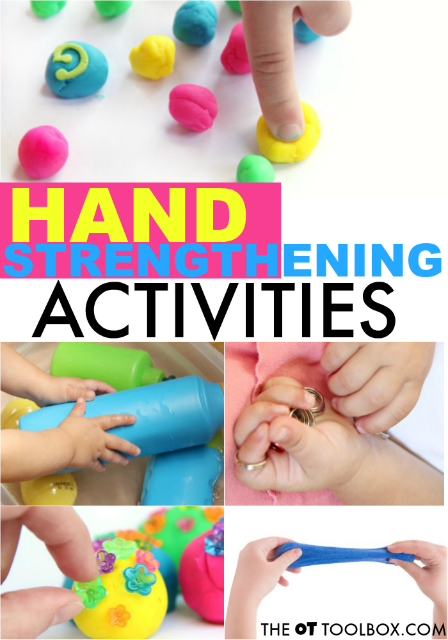
So often, we see weak arches, instability, and low tone in the hands that transfers to awkward use of the hands, impractical grasps, and poor endurance in writing or coloring. Sneaking in a few strengthening activities each day can make a world of difference!
Hand Strengthening Activities
Today includes a collection of hand strengthening activities that can be used as hand strength activities for adults, and to develop hand strength. Scroll through the activities below to find creative hand strengthening ideas to improve grip strength, pinch strength, or as part of a finger exercises program for handwriting.
What Impacts Hand Strength?
Hand strength is impacted by various components. When it comes to hand strength, there is a lot to uncover. Many aspects of motor skills impact strength and endurance in the hands. Some of those areas include these concepts:
- Intrinsic hand strength
- Thumb strength and stability
- Motor control
- Separation of the sides of the hand
- In-hand manipulation
- Wrist stability
- Wrist extension
- Finger strength
- Range of motion of the arm: upper arm, forearm, wrist, fingers, and thumb
- Hand muscle tone
A hand therapist will have various hand strength norms by using a dynamometer to measure grip strength, pinch strength of various pinches. Having an understanding of hand musculature and anatomy of the hand and upper extremity is important too.
First, check out our huge online library of fine motor activities. This is a collection of all of the fine motor activities on The OT Toolbox. There’s something for everyone.
One thing that makes a big difference in fine motor dexterity is addressing separation of the sides of the hand. This post explains more about motoric separation of the hand and here is another fun activity that really strengthens those muscles.
Intrinsic Hand Strength
These OT activities using tongs are great for developing and strengthening the arches of the hands for improved intrinsic strength.
In fact, the intrinsic muscles are the muscles in the hand that define the arches of the hands, bend the knuckles, and oppose with the thumbs. Activities like this intrinsic muscle strengthening activity can easily be replicated at home or in the therapy room.
Among these muscles are a group called the lumbricals. The lumbrical muscles have a job to bend (flex) the MCP joints and extend (straighten) the PIP and DIP joints. When the lumbricals are in action, the hand might look like it is holding a plate with the big knuckles bent and the fingers extended. Read more about strengthening the intrinsic muscles here.
When kids write or color with a thumb web space area squashed shut, it’s a sign of problems. Then might be compensating for thumb instability, underdeveloped hand arches, and/or poor strength. Each of these problem areas will lead to difficulties with handwriting, dexterity, manipulation of small items like beads, and pencil grasp.
Writing with a closed web space is inefficient and will cause poor and slow handwriting, especially as kids grow and are expected to write at faster speeds. A closed web space while attempting to manage fasteners such as buttons and zippers will lead to fumbling and difficulty. So, what do you do if you’ve got a kiddo who is squashing that web space shut during functional tasks? I’ve got a few ideas on how to work on open thumb web spaces.
Thumb Strength and Stability
Here are even more ideas to promote thumb stability and tone with activities designed to open the thumb web space.
Strengthening the hand can occur through a variety of pinch and grip exercises. Here are ideas to strengthen the hands using clothespins.
In-hand manipulation Strength
In-hand manipulation is a skill requiring strength in the hands. Activities like this in-hand manipulation activity can boost these skills.
There are several aspects to in-hand manipulation:
▪ Finger-to-Palm Translation: Movement of an object from the fingers to the palm i.e. picking up a coin and moving it to the palm.
▪ Palm-to-Finger Translation: Movement of an object from the palm to the fingertips. (i.e. moving a coin from the palm to the fingertips to insert into a vending machine.)
▪ Shift: Slight adjustment of an object on or by the finger pads. (i.e. adjusting a pencil up and down in your hand.)
▪ Simple Rotation: Turning or rolling an object 90 degrees or less with the fingers moving as a unit. (i.e. unscrewing a toothpaste lid)
▪ Complex Rotation: Turning an object more than 90 degrees using isolated finger and thumb movements. (i.e. Turning a paperclip)
Each of the above skills can occur with items “squirreled away in the palm using the pinky finger and ring finger. This is called “with stabilization”. If other items are not pocketed away in the palm while in-hand manipulation occurs, it is called “without stabilization”.
Stabilization typically occurs around 2 years of age. Read more about in-hand manipulation here. Here are a couple of activity ideas that can be easily replicated at home.
Wrist Stability and Strength
Wrist stability is one of the essential areas that impact hand strength.
Due to the anatomical nature of the tendons in the forearm and hand, a stabile wrist impacts hand strength, specifically grip and pinch.
When the wrist is flexed (bent forward towards curved fingers in a grasp), there is little chance of fine motor dexterity. A flexed wrist in functional tasks limits use of the fingers due to the tendons of the fingers being shortened as they work to stabilize the wrist. The fingers just can’t move like they are supposed to.
There are many exercises and activities that can be done to build the stability of the wrist so that it maintains a slightly extended position during fine motor activities.
Upper Body Strength Impacts Hand Strength
Upper body strength is made up of the muscles in the upper chest, muscles in the upper back and muscles attached to the shoulder joint. All of these muscles work together to create stability at the shoulder joint. This shoulder girdle stability is essential for establishing a solid anchor for the rest of the arm. Without this anchor it is difficult to develop good control in the lower arm, hands and fingers. In therapy-speak we talk about developing proximal stability before we can achieve distal control.
The stronger body enables functional performance in purposeful activities, specifically strong and efficient hands.
hand strengthening activities:
Hand strengthening activities can use the items you have in your home or therapy bag. Activities that involve play are best for developing hand and finger strength in kids. Some of these ideas can integrate play and stronger hands:
- Squeeze play dough or a stress ball
- Drop beans into a bottle to make a sensory bottle
- Use a hole punch to create confetti for crafting
- Everyday play activities using small toys or manipulatives
- Weightbearing activities: play games on the floor
- Pop bubble wrap
- Attach paperclips onto the edge of a paper
- Shoot a marble into a target with the thumb
- Screw together nuts and bolts
- Tear pieces of paper
- Make dough and roll and cut cookies
- Sort, stack, and drop coins into a bank
- Use a stapler and staple remover on a bulletin board
- Freeze playdough and cut it with scissors
- And then cut playdough with scissors!
- Cut a slit in a tennis ball and “feed” it small objects
- Stack mini erasers
- Open and close jars and containers
- String small beads onto string or a pipe cleaner
- Tie and untie knots
- Pop beads
How will you use the hand strengthening activities and ideas listed above? Maybe in a home exercise program or in a therapy program that runs throughout the school year? Maybe you will use the ideas at home or in a clinic. The ideas are endless!
Hand Strengthening Exercises
Think about it, how much do you use your hands throughout the day? Would you say it is from the moment you turn off your alarm clock in the morning to the minute you cover up in bed at night? How about the times you use them during the night, such as when you go to the bathroom or readjust the covers or the pillow?
If you’re like many of us, the list of necessary tasks you need to do using your hands each day could go on and on and on. No matter how often you use your hands, they need to be in good shape and strong enough to manage all the tasks you need and want to do daily.
However, with children, they don’t necessarily think about the times they need to use their hands and the strength the hands need throughout the day, but we bet they often think of the times that their hands have failed them and they were too weak and they couldn’t accomplish the tasks and activities that were important to them. We do believe they think about those times.
On a personal note, I work with many kids in the clinic that struggle with cutting, coloring, handwriting, drawing, pencil grasp, gameplay, dressing, and other self-care skills and the one factor that often comes into play with my kiddos is their decreased hand and finger strength.
For this blog post, we will be addressing hand strength exercises and activities that can be used in the clinic, classroom, and home setting with many of them simply using some inexpensive supplies that you may already have on hand.
Some are direct exercises for older kids while some will be fun game-like exercises or activities for younger kids because we all know children need to be motivated at their level of age and level of interest, that’s why we’ve given you a variety of ideas. Now, let’s get started with some fun, meaningful, and hopefully successful hand strengthening exercises and activities.
Also, one last note, please don’t forget that even gross motor activities can also help build hand strength too! So, keep children doing animal walks, crawling, heavy work exercises, pulling themselves while prone on a scooter board, weight-bearing over therapy balls, climbing, and playing on the playground equipment.
hand strengthening exercises for kids
Below are hand strengthening exercises for kids that use a variety of different materials. You’ll find different activities and ideas under each section.
Therapy putty exercises:
- power grip is simply taking a ball of therapy putty and squeezing with a gross grasp until as flat as possible, repeat
- flat pinch is taking the therapy putty and creating a fat therapy log for the fingers to pinch flat as they attempt to stay, repeat
- full grip is taking the therapy putty and creating a fat therapy log placing it vertically within the hand and then squeezing to make the log grow out of the top within the webspace, repeat
- thumb press is taking a log or ball of putty and squeezing or pressing the thumb into the ball or log, repeat
- finger curl is taking the therapy putty and placing at the base of the fingers within the palm and then squeezing the fingers into the putty making and fist, repeat
Squeeze ball exercises:
- gross grasp is squeezing the ball repeatedly with the whole hand and holding for 3-5 seconds and repeating multiple times
- gross grasp with a squeeze ball that has a face – simply squeeze with the whole hand to distort the face on the squeeze ball
Squeeze and feed the tennis ball (the size of the slit opening can make the ball easier or more difficult to squeeze open)
- squeeze the ball open to feed the ball individual objects
- squeeze the ball and scoop dry beans with a spoon to feed the ball
Rubber band exercises
- wrap rubber bands around the fingers including the thumb and then stretch out the hands and fingers to spread the fingers outward as far as possible, repeat
Hand pushes and pulls
- simply place palms of hands together and push together, repeat
- place a small squeeze ball between the palms of the hands and push together to flatten the ball, repeat
- simply intertwine fingers together and attempt to gently pull them apart, repeat
Palm rotation with bounce balls or marbles
- place 2-4 marbles or small bounce balls into the palm of the hand and attempt to rotate them in a circle while only using one hand
Fist to fan to fist fingers
- open the hand by fanning (spreading) out the fingers and hold
- close the hand by fisting the fingers together and hold
Make an O to fan to O position
- curl the fingers into an O shape and hold
- open the fingers into a fan and hold
Piano push
- slightly curl the fingers like playing the piano and then push against a stable surface such as a tabletop or wall, repeat
Crumbling paper balls
- bilateral – use two hands with both working individually to crumple flat sheets of paper into paper balls (you can re-use each sheet by flattening the sheet again after crumpling or you can use a new sheet)
- unilateral – use one hand at a time to crumple flat sheets of paper into paper balls (same as above you can re-use each sheet or you can use a new sheet)
Wringing water out of washcloths or sponges
- bilateral – use both hands together to twist and wring out a wet washcloth or a small hand towel
- unilateral – use one hand at a time to squeeze a wet washcloth to wring out the water
- bilateral/unilateral – use two hands at the same time, but both working individually to squeeze water out of sponges
Create tongs out of a Pringle’s lid or other large flexible lids
- use these recycled lids as tongs and squeeze with the whole hand to pick up objects and sort them
Condiment bottles and a turkey baster
- use condiment bottles or a turkey baster to blow cotton balls or pom-pom balls in a fun race against a partner (you can use one or two hands to squeeze)
Milk the latex glove
- this hand strengthening exercise is where you fill a latex glove with water and then knot the opening. Use a pin to poke a small hole into the tip of each finger then a child will work on squeezing the water out of each finger like milking a cow.
Spray bottle
- use a spray bottle to form letters on the sidewalk or side of the building
- use the spray bottle to clean a chalkboard
Robot or Gripper claw apparatus
- full hand reacher and/or gripper apparatuses are easy for kids to use to pick up objects at a distance to transport to a nearby laundry basket or box or simply from left side to right side or vice versa
Office supply tool use to promote hand strength when in use:
- Stapler to staple along a strip of paper or even around shapes
- Hole punch to punch holes along a strip of paper or even around shapes
- Bottle glitter glue to trace letters or shapes
- Rubber band wrap to wrap around a canned good or a fun pool noodle friend
- Marker cap removal or matching to simply remove and put back on the marker or before use mix up the color caps on the markers and have the child fix your mix-up of marker caps
- Scissor cutting with play dough or putty to cut play dough or putty logs or snakes into pieces
House tool use to promote hand strength when in use:
- New plunger removal from the floor (ugh, don’t use a used one) – simply use it on a hard floor surface to push down and pull up
- Pushing and pulling a weighted laundry basket – simply have a child push a weighted laundry basket across the floor or tie a rope onto the basket and have a child pull it hand-over-hand to themselves
- Pulling a rope with any weighted object on the end such as a weighted scooter board, box, or even a chair – make sure they use hand-over-hand
- Pull pieces of Velcro apart – you can use large strips
- Place whole hand chip clips onto the edge of a box, rope, etc., and remove
- Grasp and lift a canned good for hand strength in all planes – up, down, left, right, cross midline, bicep curl, etc.
- Roll a water bottle or canned good in the open hand while supine on the tabletop – probably for an older kiddo
- Palm down wrist flexion exercise – drape over the edge of a table and grasp a water bottle or dumbbell and flex up while lifting – probably for an older kiddo
- Bean bag spatula flip (grasp activity) – use bean bags and a kitchen spatula to flip bean bags from one side to the other
Use commercially available tools and games to promote hand strength (Amazon affiliate links included below):
Amazon affiliate links are included in this blog post. As an Amazon Influencer, I earn from qualifying purchases.
- Pop Toobs – pull apart for the fun sound and push together to do again or use more than one and link them together. Read about how to use pop tubes for fine motor skills.
- Squigz – push onto a dry erase board, hard surface floor, or therapy ball and pull off in a color sequence
- Squeeze animals – distort their bodies and faces or use bath toys that blow air, have children blow small pieces of cotton balls or pom-pom balls in a race against a partner
- Plastic and wood food-cutting toys – use the plastic or wood knife to cut food apart into pieces
- Lego brick building and destruction – use the bricks to build simple towers or even buildings or objects with the use of picture cards
- Build and destruct Mr. Potato Head – use the fun game to work on hand strengthening. They can build the correct way or a distorted way for fun.
- Build and destruct Cootie Bugs using the fun game to work on hand strengthening. This one is a little tricky for younger kiddos as the legs must go in at a slight angle which may make them more appropriate for older kiddos.
Would you like a fun game-like resource that addresses both hand and finger strengthening? Add these fun resources to your toolkit – Finger and Hand Exercise Game Boards and Year-Round Play Dough Game Boards.
These resources include 10-12 no-prep game boards that you can print and play to practice finger isolation, left and right-hand discrimination, overall fine motor coordination, finger dexterity and build hand and finger strength. If you want to jazz up any warm-up routine, these are what you need as they are engaging for kids and are a great tool to use before coloring, cutting, handwriting, or typing work.
Want to read more about hand strengthening and further build your therapist toolkit? Take a look at the other posts found right here at The OT Toolbox:
It’s my hope that these resources are a huge help for you! Here are a few more topics related to strength in the hands that you may need in your therapy toolbox:
- Graded Precision in Grasp
- Occupation-Centered Neat Pincer Grasp Activities
- Strengthen Tripod Grasp with Every Day Items
- DIY Clothespin Busy Bags to Strengthen Pinch
- Pinch and Dexterity Activity
- Clay Strengthening Exercises
- Handwriting Warm-Up Exercises
- The Ultimate Guide to Fine Motor Strength
- Hand Strengthening Activity with Blocks and Rubber Bands
- Intrinsic Hand Muscle Strengthening with Tongs
- Slime Hand Strength Exercises
- Play Dough Hand Strength Astronaut Activity
- Hand Strengthening Activity with an Egg Carton

Colleen Beck, OTR/L has been an occupational therapist since 2000, working in school-based, hand therapy, outpatient peds, EI, and SNF. Colleen created The OT Toolbox to inspire therapists, teachers, and parents with easy and fun tools to help children thrive. Read her story about going from an OT making $3/hour (after paying for kids’ childcare) to a full-time OT resource creator for millions of readers. Want to collaborate? Send an email to contact@theottoolbox.com.
Working on fine motor skills, visual perception, visual motor skills, sensory tolerance, handwriting, or scissor skills? Our Fine Motor Kits cover all of these areas and more.
Check out the seasonal Fine Motor Kits that kids love:


















Or, grab one of our themed Fine Motor Kits to target skills with fun themes:
- Frogs Fine Motor Kit
- Unicorns Fine Motor Kit
- Vehicles Fine Motor Kit
- Apple Fine Motor Kit
- Back to School Kit
- Sports Fine Motor Kit
- Outer Space Fine Motor Kit
- Fairytale Fine Motor Kit
- Plus more in our shop!
Want access to all of these kits…and more being added each month? Join The OT Toolbox Member’s Club!


